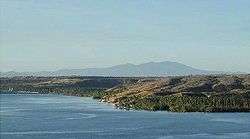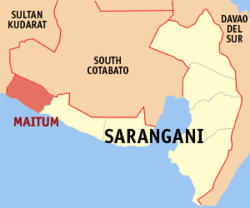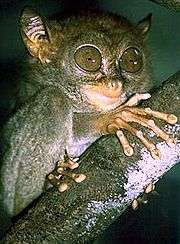Maitum, Sarangani
| Maitum Blackstone | |
|---|---|
| Municipality | |
| Municipality of Maitum | |
 Coastal view of Maitum | |
| Etymology: Black stone | |
| Nickname(s): Blackstone | |
| Motto(s): Masaganang Maitum | |
 Map of Sarangani with Maitum highlighted | |
.svg.png) Maitum Location within the Philippines | |
| Coordinates: 6°02′N 124°29′E / 6.03°N 124.48°ECoordinates: 6°02′N 124°29′E / 6.03°N 124.48°E | |
| Country |
|
| Region | Soccsksargen (Region XII) |
| Province | Sarangani |
| District | Lone District |
| Founded | May 7, 1959 |
| Named for | Black Stone |
| Barangays | 19 (see Barangays) |
| Government [1] | |
| • Type | Local Government Unit |
| • Mayor | Tito T. Balazon, Sr. |
| • Electorate | 30,312 voters (2016) |
| Area [2] | |
| • Total | 290.66 km2 (112.22 sq mi) |
| Population (2015 census)[3] | |
| • Total | 44,595 |
| • Density | 150/km2 (400/sq mi) |
| Time zone | UTC+8 (PST) |
| ZIP code | 9515 |
| PSGC | 128005000 |
| IDD : area code | +63 (0)83 |
| Climate type | Tropical rainforest climate |
| Income class | 2nd municipal income class |
| Revenue (₱) | 126,450,307.41 (2016) |
| Native languages |
Cebuano Tboli Maguindanao language Blaan language Tagalog |
| Website |
www |
Maitum, officially the Municipality of Maitum, is a 2nd class municipality in the province of Sarangani, Philippines. According to the 2015 census, it has a population of 44,595 people.[3]
It is bordered on the west by the province of Sultan Kudarat, on the east by the municipality of Kiamba, on the north by the province of South Cotabato, and on the south by the Celebes Sea.
History
According to local folklore, "Maitum" refers to the black stones in Saub River. It is believed that the river stones turned black when the local native princess and her warrior lover passed through it as they eloped and escaped from the wrath of the princess' father who disapproved their marriage. "Maitum" is a native word meaning black.
In 1928, Maitum became part of the municipality of Kiamba. It became a separate municipality on May 7, 1959, through Republic Act No. 2189.
Barangays
Maitum is politically subdivided into 19 barangays.
- Batian
- Kalaneg
- Kalaong
- Kiambing
- Kiayap
- Mabay
- Maguling
- Malalag
- Mindupok
- New La Union
- Old Poblacion
- Pangi
- Pinol
- Sison
- Ticulab
- Tuanadatu
- Upo
- Wali
- Zion
Demographics
| Population census of Maitum | ||
|---|---|---|
| Year | Pop. | ±% p.a. |
| 1990 | 25,640 | — |
| 1995 | 35,009 | +6.01% |
| 2000 | 35,536 | +0.32% |
| 2007 | 37,054 | +0.58% |
| 2010 | 41,675 | +4.37% |
| 2015 | 44,595 | +1.30% |
| Source: Philippine Statistics Authority[3][4][5][6] | ||
The majority of the population are of Ilocano origin. One of the indigenous peoples living in mountainous areas of Maitum is known as T'boli. The annual Binuyugan Festival is celebrated in May.
Internationally, Maitum is known for the discovery of very old cave artifacts called Maitum Anthropomorphic Potteries in one of the caves nearby. Ancient burial jars were discovered by archaeologists from the National Museum in Ayub Cave, Maitum, in 1991 and in 2008, at Sagel Cave, Maitum (now declared by National Historical Institute as a national historical sites). Amid Mindanao's armed conflicts, artifacts found thereat prove settlements of pre-historic civilization in Maitum.[7][8]
Economy

The economy of Maitum is largely based on agriculture and is often called the "rice-granary" of Sarangani due to its high level production of rice. Aqua-culture is the second biggest income earner, notably the culture of milkfish (bangus), prawns (particularly giant prawns) and shrimps for export. Other agricultural products are coconuts, corn, rubber, bananas, mangoes, pork, eggs, beef, and fish. Maitum is also a food basket nationally famous for its marinated flying fish.
The economy has accelerated in the past decade driven by advances in global communication technology and the finishing of a modern highway that tremendously improved trade and transport.
Wildlife

Tarsiers have been discovered in Maitum's mountainous areas.
Caves and the rainforest of Maitum are the natural habitat of a rare fruit bat species called giant golden-crowned flying fox (Acedoron jubatus), also known as "silent planter," since it contributes greatly to forest regeneration, because of eating lots of fruits and their seeds.[9] The rare writhed-billed hornbill and Mindanao hornbill are also found in the surrounding rainforest. The Philippine eagle (a monkey-eating eagle) also thrives in the area.
Endangered hawksbill turtles have their nesting grounds in Maitum's former main village called "Old Poblacion".
Other wild animals are wild boar, deer, monkeys, and various species of snake.
Sea turtles or pawikan can also be found in Maitum, Sarangani specifically at the Pawikan Nesting Sanctuary founded in 2003.
Cultural Heritage
.jpg)
The town is the location where the Maitum Anthropomorphic Pottery or Maitum Jars were found.
In 1991, the National Museum archaeological team discovered anthropomorphic secondary burial jars in Ayub Cave, Barangay Pinol, Maitum, Sarangani, Mindanao, Philippines. The jars are commonly known today as Maitum jars. They are made of earthenware, and are characterized by their design that suggests human figures with complete or partial facial features of the first inhabitants in Mindanao. Furthermore, they give emphasis to the Filipinos’ popular belief of life after death.
According to Dr. Eusebio Dizon, head of the archaeological team, this type of burial jars are “remarkably unique and intriguing” because they have not been found elsewhere in Southeast Asia. Thus, many archaeologists from Vietnam, Thailand, Malaysia, Laos, Cambodia, Burma and Indonesia gained interest on this initial find and a number of archaeological - either government or privately sponsored - excavations have been conducted to recover these artifacts.
These jars have characteristics that belong to the Developed Metal Age Period in the Philippines [calibrated date of 190 BC to 500 AD]. According to the laboratory results determined through radiocarbon dating, these secondary burial jars date back to the Metal Age. Two conventional dates were 1830 +/-60 B.P. [calibrated date of AD 70 to 370] and 1920 +/- 50 B.P. [calibrated date of 5 BC to 225 AD]. Experts used soot samples taken from the walls of a small earthenware vessel found inside one of the larger burial jars.[10]
Most of the jars are now on display at the National Museum of the Philippines in Manila. The town has a museum with Maitum jars, however, the jars are only replicas. According to the town government, they intend for the Maitum jars to be returned to Maitum town from Manila once a proper museum with high-tech conservation capabilities has been established. Unfortunately, funding for the museum from the national government is scarce. Museum researchers have speculated that many Maitum jars have been looted before their initial discovery, as many jars have been seen in the black market.
The Maitum Jars have been declared as National Treasures of the Philippines and Important Cultural Properties of the Philippines, meaning, they must never get out from the country and should be conserved by all means. Found jars should be directly given to the government for proper conservation for future generations, and must not be sold to collectors. Violating the law that safeguards the Maitum jars will lead to imprisonment of up to 20 years and payment for damages up to 250,000 pesos. Unfortunately, despite the high regard of scholars on the Maitum jars, in an interview of townsfolk in 2012, majority of the residents of Maitum town are unaware of the cultural value of the jars. The interview noted the need for a public awareness campaign on the importance of the Maitum jars for the town's heritage, especially to the barangays within the caves they were found in.
Some locals have said that they have sold jars to foreigners, who pay them a hefty price. Locals would sometimes throw away jar shards as well. On top of that, the caves where the jars were initially found have repeatedly been ransacked since there are no physical protections in the site. There are no site guards or a conservation station located within the vicinity of the cave despite being discovered around 3 decades ago. Many jar shards exist in the caves and are left unprotected, despite the caves being declared as a heritage site. Due to these factors, despite many scholars wanting to campaign the declaration of the town as a UNESCO World Heritage Site, such declaration would be hard to achieve due to the lack of public awareness in the town itself, mindfulness for cultural heritage in the town, and physical and a better legal protection for the caves and its jars.[11]
References
- ↑ "Municipality". Quezon City, Philippines: Department of the Interior and Local Government. Retrieved 31 May 2013.
- ↑ "Province: Sarangani". PSGC Interactive. Quezon City, Philippines: Philippine Statistics Authority. Retrieved 12 November 2016.
- 1 2 3 Census of Population (2015). "Region XII (Soccsksargen)". Total Population by Province, City, Municipality and Barangay. PSA. Retrieved 20 June 2016.
- ↑ Census of Population and Housing (2010). "Region XII (Soccsksargen)". Total Population by Province, City, Municipality and Barangay. NSO. Retrieved 29 June 2016.
- ↑ Censuses of Population (1903–2007). "Region XII (Soccsksargen)". Table 1. Population Enumerated in Various Censuses by Province/Highly Urbanized City: 1903 to 2007. NSO.
- ↑ "Province of Sarangani". Municipality Population Data. Local Water Utilities Administration Research Division. Retrieved 17 December 2016.
- ↑ pia.gov.ph, Island resort now Sarangani landmark Archived 2009-02-11 at the Wayback Machine.
- ↑ balita.ph/2008/11, Sarangani gears for foundation anniversary festival
- ↑ www.gmanews.tv/video, Born to be Wild: Giant Bats, 07/03/2008
- ↑ Dizon, E. (1996). Faces from Maitum: The archaeological excavation of Ayub Cave. Manila: National Museum of the Philippines. pp. xi–xii, 51–53, 56–59, 73, 78–82.
- ↑ https://www.youtube.com/watch?v=bZKrQSAC27E
External links
| Wikimedia Commons has media related to Maitum, Sarangani. |
- Maitum Municipal Profile at the Province of Sarangani Official Website
- Official Website of the Municipality of Maitum
- Philippine Standard Geographic Code
- Philippine Census Information
- Local Governance Performance Management System
- Maitum cave yields artifacts similar to 1991 find
- globalnation.inquirer.net